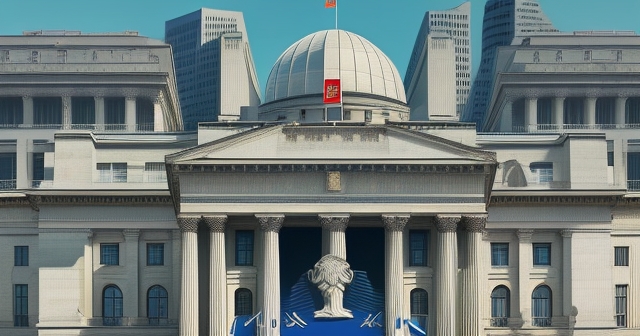
Central Banks Rates Forex: How They Influence Currency Trading
“`html
Table of Contents
ToggleUnderstanding Central Banks and the Power of Interest Rates: A Trader’s Essential Guide
Welcome to this deep dive into the fascinating world of central banking and its profound influence on global financial markets, particularly the Forex market. If you’re new to trading or looking to solidify your understanding of the fundamental forces driving currency movements, you’ve come to the right place. We’ll explore how these powerful institutions operate and why their every move, especially regarding interest rates, demands your attention.
Think of central banks as the ultimate custodians of a nation’s or region’s economic health. They are public institutions entrusted with managing a country’s currency, controlling the overall supply of money, and, crucially, implementing monetary policy. Their primary goal? To foster stable economic conditions, which usually involves keeping inflation in check while promoting sustainable growth and employment. It’s a delicate balancing act, and their main tool for this is something you’ve probably heard a lot about: interest rates.
We’re not talking about the interest rate on your savings account or mortgage here, though those are certainly affected. Central banks set a base or policy interest rate. This is essentially the rate at which commercial banks can borrow money directly from the central bank. By setting this rate, they influence the cost of borrowing money throughout the entire economy, from large corporations to individual consumers like you and us. This mechanism is incredibly powerful, acting like a thermostat for economic activity.

Interest rates play a crucial role in shaping economic activities. Here are some key points to consider:
- Interest rates directly affect borrowing costs.
- Changes in interest rates can influence consumer spending and investment.
- Central banks adjust rates to maintain economic stability.
Interest Rates: The Primary Lever of Monetary Policy
At its core, monetary policy is about managing the money supply and credit conditions to influence economic activity. And the policy interest rate is the central bank’s most conventional and frequently used instrument to achieve this. Why is it so effective?
When the central bank raises the policy rate, it becomes more expensive for commercial banks to borrow money. This cost is then passed on to businesses and individuals through higher loan rates for everything from mortgages and car loans to business investments. Higher borrowing costs tend to cool down spending and investment, which can help to curb inflation and prevent the economy from overheating. It’s like tightening the reins on a galloping horse.
Conversely, when the central bank lowers the policy rate, borrowing becomes cheaper. This encourages banks to lend, businesses to invest, and consumers to spend. Lower interest rates can stimulate economic activity, boost growth, and help an economy recover from a slowdown or recession. This is akin to giving the economy a shot of adrenaline.
Understanding this fundamental relationship – central bank sets rate, influences borrowing costs, affects economic activity – is the absolute bedrock for comprehending how monetary policy impacts financial markets. It’s the engine that drives many of the movements you’ll see in currency pairs, bond prices, and equity valuations.
How Central Banks Use Rate Hikes and Cuts: Navigating the Economic Cycle
Central banks don’t just arbitrarily change interest rates. Their decisions are based on careful analysis of numerous economic indicators and forecasts. They are constantly assessing the economy’s health, looking for signs of excessive inflation, sluggish growth, or potential instability.
A decision to implement rate hikes is typically made when an economy is showing strong signs of growth, and particularly when inflation is rising or expected to rise above the central bank’s target level. Inflation erodes the purchasing power of money, and central banks are mandated to maintain price stability. By making money more expensive to borrow, they aim to slow down demand, reduce inflationary pressures, and guide the economy towards a more sustainable pace of expansion. It’s a preemptive or reactive measure to prevent the economy from becoming inflationary and unstable.

On the other hand, rate cuts are deployed when the economy is struggling. Signs of a slowdown might include falling GDP growth, rising unemployment, or deflationary risks (a sustained decrease in price levels, which can be very damaging). In such scenarios, the central bank lowers interest rates to make it cheaper for businesses and consumers to borrow and spend, thereby injecting liquidity into the financial system and stimulating demand. This encourages investment, hiring, and consumption, aiming to pull the economy out of a slump.
Sometimes, central banks might also choose to hold rates steady. This happens when they believe the current monetary policy stance is appropriate for the prevailing economic conditions and outlook. It provides stability and allows them time to assess the impact of previous policy actions and gather more data before making the next move. Monitoring whether a central bank is expected to hike, cut, or hold rates is a critical part of market analysis, as it directly influences expectations about future economic conditions and asset valuations.
Major Global Central Banks and Their Current Stance
The global financial system is interconnected, and the actions of major central banks resonate far beyond their own borders. As a trader, it’s essential to be aware of the key players and their current policy leanings. While we won’t list every single central bank, focusing on the ones tied to the most actively traded currencies gives you a strong foundation.
Let’s look at some of the most influential central banks mentioned in our data and understand their typical approach:
| Central Bank | Country/Region | Primary Objective |
|---|---|---|
| The Federal Reserve (Fed) | United States | Maximum employment and stable prices |
| The European Central Bank (ECB) | Euro Area | Price stability |
| The Bank of Japan (BoJ) | Japan | Combat deflation and stimulate economy |
| The Bank of England (BoE) | United Kingdom | Maintain price stability |
Keeping a table or list of the current policy rates for these and other major central banks, along with their recent changes and the dates of their upcoming meetings, provides you with a vital snapshot of the global monetary policy landscape. This forms the basis for understanding potential currency movements.
The Direct Impact of Interest Rates on Forex Markets
For Forex traders, understanding central bank interest rates is not just helpful; it’s absolutely essential. Interest rate differentials between countries are a primary driver of currency valuations and movements.
Here’s the fundamental principle: Higher interest rates tend to attract foreign capital seeking better returns. If a country’s central bank raises interest rates, it makes investments in that country’s assets (like bonds) more attractive compared to those in countries with lower rates. International investors looking for higher yield will buy that country’s currency to invest there. This increased demand for the currency can cause it to strengthen relative to others. Conversely, lower interest rates can make a country’s assets less attractive, potentially leading to capital outflows and a weakening currency.

Consider a simple example: If the Fed raises rates while the ECB holds rates steady, US dollar assets become more attractive relative to Eurozone assets. Investors might sell Euros to buy Dollars and invest in the US, increasing demand for USD and potentially causing the EUR/USD pair to fall. This is a simplified view, of course, as many other factors are at play, but the principle of yield differential driven by interest rates is a powerful force.
This effect is particularly evident in the “carry trade,” where investors borrow in a low-interest-rate currency and invest in a high-interest-rate currency to profit from the rate differential. While carry trades involve risk, the underlying principle illustrates how interest rate differentials directly influence currency demand.
Furthermore, expectations about future interest rate changes are often more impactful than the actual change itself. If the market strongly anticipates a rate hike from a central bank, the currency may strengthen in the weeks or months leading up to the decision as traders position themselves. If the central bank then disappoints the market by not hiking, the currency could fall sharply (a “sell the rumour, buy the fact” or “buy the rumour, sell the fact” dynamic, depending on the outcome). This highlights the importance of not just knowing the current rate but also understanding market expectations and central bank communication.
If you’re navigating the Forex market and looking to put this knowledge into practice, choosing a robust trading platform is key. The right platform can offer you access to various currency pairs affected by these global interest rate dynamics.
The impact isn’t limited to major currency pairs like EUR/USD, GBP/USD, AUD/USD, or USD/CAD. Emerging market currencies are also highly sensitive to interest rate differentials and global capital flows influenced by the policies of major central banks like the Fed or ECB. For instance, a strengthening USD driven by Fed rate hikes can put downward pressure on currencies like the Chinese Yuan (CNY), influencing pairs like USD/CNY, and potentially forcing the PBoC to adjust its own policy or reference rates to manage currency stability.
Interest Rates’ Ripple Effect on Bonds and Equities
While Forex is perhaps the most directly and immediately impacted market by interest rate decisions, the effects ripple outwards to influence other major financial asset classes as well: bonds and equities.
For bonds, the relationship with interest rates is generally inverse. When interest rates rise, newly issued bonds offer higher yields, making existing bonds with lower yields less attractive. To sell existing bonds, their price must fall to make their yield competitive with current market rates. Conversely, when interest rates fall, existing bonds with higher yields become more valuable, and their prices rise.
The yield on government bonds, in particular, is heavily influenced by central bank policy rates and market expectations about future rates. These bond yields serve as benchmarks for many other borrowing costs in the economy and are closely watched by investors across all markets.
The impact on equities (stocks) is more complex but still significant. Higher interest rates increase the cost of borrowing for companies, which can reduce investment, slow down growth, and potentially lower profits. Higher rates also make bonds and other fixed-income investments more attractive relative to stocks, potentially leading investors to shift capital out of equities. These factors tend to put downward pressure on stock valuations. You might see broad market indices like the S&P500 react negatively to aggressive rate hike cycles.
Conversely, lower interest rates reduce borrowing costs for companies, encourage investment, and make bonds less attractive compared to stocks. This environment is generally supportive of higher equity valuations. However, rate cuts often occur when the economy is weak, which can negatively impact corporate earnings despite lower borrowing costs. So, the equity market reaction to rate cuts can be mixed, depending on the perceived reason for the cut (stimulus vs. reaction to severe weakness).
Understanding how interest rates affect bonds and equities provides a broader picture of the financial landscape. It helps you see how central bank actions influence not just currency pairs but also the overall market sentiment and the attractiveness of different asset classes. This interconnectedness means that a major central bank decision can trigger shifts across Forex, bond, and equity markets simultaneously.
Beyond the Rate Decision: Central Bank Communication
In modern central banking, communication is almost as powerful a tool as the interest rate itself. Central bankers understand that markets react not just to what they *do*, but also to what they *say* and what they *signal* they might do in the future. This is often referred to as forward guidance.
Central bank officials regularly give speeches, hold press conferences after policy meetings, and publish minutes or summaries of their discussions. They also participate in forums and conferences with other economists and policymakers. All of these avenues are used to explain their current policy stance, provide their assessment of the economic outlook, and offer clues about the likely future path of interest rates and other policy tools.
Why is this so important? Because market expectations play a huge role in asset prices. If a central bank can effectively communicate its intentions, it can guide market expectations and influence long-term interest rates and asset prices even before the actual policy change occurs. For instance, if a central bank signals that rate hikes are coming, long-term bond yields might start to rise, and the currency might appreciate in anticipation.

Specific events are particularly high-profile platforms for central bank communication. The annual Jackson Hole Symposium, for example, brings together central bankers, economists, and financial market participants from around the world. Keynote speeches at this event, such as those historically delivered by the Fed Chair (Jerome Powell gave a significant one in 2024), are scrutinized for any hints about future policy direction. A speech might signal a potential “dovish pivot” (moving towards lower rates or a less aggressive stance) or a “hawkish” turn (moving towards higher rates or a more aggressive stance), causing immediate and substantial market reactions.
Monitoring the language used by central bankers – whether they sound more concerned about inflation (hawkish) or about economic growth (dovish) – provides invaluable insights into their priorities and potential future actions. These communications offer a window into the central bank’s thinking process and help you understand the rationale behind their decisions.
Key Economic Data Shaping Policy Decisions
Central bank decisions are data-dependent. They rely heavily on a constant stream of economic indicators to assess the current state of the economy and forecast its future trajectory. As a trader trying to anticipate central bank moves, paying attention to the same data points they do is crucial.
Some of the most important economic indicators include:
| Economic Indicator | Importance |
|---|---|
| Consumer Price Index (CPI) / Inflation Data | Critical for assessing inflation |
| Gross Domestic Product (GDP) | Indicates economic growth |
| Employment Data | Reflects labor market health |
| Retail Sales | Measures consumer spending |
| Manufacturing and Services PMIs | Forward-looking view of business activity |
Central banks analyze these and many other data points in combination. A single piece of data might not change policy, but a consistent trend or a significant deviation from expectations can influence their assessment of economic health and their subsequent policy response. Monitoring economic calendars for the release of these key data points is a fundamental practice for traders trying to understand central bank motivations.
Significant Events and Forums: Jackson Hole and Beyond
Beyond the regular monetary policy meetings and data releases, certain events and forums hold particular weight in the central banking world. These gatherings often serve as platforms for policymakers to discuss pressing economic issues and signal potential shifts in thinking.
We’ve already mentioned the Jackson Hole Symposium, hosted annually by the Federal Reserve Bank of Kansas City. This event brings together top central bankers, finance ministers, academics, and financial market participants. The setting, far from the daily hustle of financial centers, often encourages more open and analytical discussions about long-term policy challenges. As highlighted by the provided data, speeches at Jackson Hole, such as Jerome Powell’s keynote in 2024 focusing on reassessing monetary policy effectiveness, can be pivotal in signaling policy direction and generating market volatility.
Other significant events include the annual meetings of the International Monetary Fund (IMF) and the World Bank, where central bankers and finance officials from member countries gather to discuss global economic issues. While not focused solely on monetary policy for one country, these meetings can reveal coordinated or diverging views on global challenges like inflation, growth, and financial stability, which can indirectly influence individual central banks’ stances.
Understanding that these events are not just academic discussions but are actively monitored by market participants for policy clues underscores their importance. Keeping track of the dates and agendas for these major forums allows you to anticipate potential sources of market-moving news and commentary from key central bank figures.
Engaging with the global financial markets, especially Forex and other instruments like CFDs (Contracts for Difference) on indices, commodities, and even bonds, requires a platform that not only gives you access but also the tools to react quickly to news from these key events and data releases. If you’re considering a platform to trade based on these macroeconomic drivers, exploring your options is a smart move.
Navigating the Central Bank Landscape as a Trader
So, how do you take all this information about central banks, interest rates, data, and communication and apply it to your trading?
First, make it a habit to monitor the economic calendar. Know when major central banks are scheduled to meet and when key economic data releases are expected, especially inflation and growth figures. These are often periods of increased volatility in the relevant currency pairs.
Second, pay attention to central bank communication. Read or listen to press conferences and speeches from key officials. Look for shifts in language or tone that might indicate a change in their assessment of the economy or their policy intentions. Don’t just focus on the decision itself, but also the forward guidance they provide about the *future* path of rates.
Third, understand market expectations. Financial news outlets and analysts constantly discuss what they expect central banks to do. Tools like FedWatch (for the US) or similar indices for other countries track the probability of rate changes priced into futures markets. If the market is pricing in a certain outcome and the central bank delivers something different, the market reaction can be substantial.
Fourth, consider the interest rate differential. While not the only factor, the difference in policy rates between two countries whose currencies you are trading is a fundamental driver, particularly over longer time frames. Anticipated changes in this differential are often priced into the currency pair.
Fifth, integrate this macroeconomic analysis with your technical analysis. Fundamental drivers like interest rates often initiate major trends or provide the momentum behind breakouts on charts. Technical analysis can help you time your entries and exits based on the fundamental trends driven by central bank policies.
Finally, remember that central banking is complex, and outcomes are never guaranteed. Unexpected economic data, geopolitical events, or changes in central bank assessments can lead to surprises. Always manage your risk and avoid betting your entire capital on a single central bank decision.
Conclusion: Central Banks Remain at the Helm
In the intricate dance of global finance, central banks, through their management of interest rates and monetary policy, continue to hold significant sway. Their decisions are not just bureaucratic formalities; they are powerful levers that directly influence borrowing costs, economic activity, and the valuation of assets across Forex, bond, and equity markets.
For you, whether you are just starting your trading journey or aiming for a deeper understanding, recognizing the central role of these institutions is fundamental. By diligently monitoring their policy decisions, paying close attention to their communication and forward guidance, and staying informed about the key economic data that informs their choices, you gain invaluable insights into the forces shaping the markets you trade.
Understanding central banks allows you to move beyond simply reacting to price movements and begin to anticipate the potential fundamental drivers behind them. It equips you with a more comprehensive framework for analyzing currency pairs and other financial instruments affected by global monetary policy. This knowledge is a cornerstone of informed trading and helps you navigate the markets with greater confidence and foresight.
central banks rates forexFAQ
Q:What is the role of central banks in the economy?
A:Central banks manage a country’s currency and monetary policy to ensure economic stability and growth.
Q:How do interest rates affect Forex trading?
A:Interest rates influence currency valuations; higher rates typically attract foreign investment, strengthening the currency.
Q:What is forward guidance?
A:Forward guidance is communication from central banks about future policy directions, influencing market expectations and asset prices.
“`
You may also like
Calendar
| 一 | 二 | 三 | 四 | 五 | 六 | 日 |
|---|---|---|---|---|---|---|
| 1 | 2 | 3 | 4 | 5 | 6 | 7 |
| 8 | 9 | 10 | 11 | 12 | 13 | 14 |
| 15 | 16 | 17 | 18 | 19 | 20 | 21 |
| 22 | 23 | 24 | 25 | 26 | 27 | 28 |
| 29 | 30 | 31 | ||||
發佈留言
很抱歉,必須登入網站才能發佈留言。